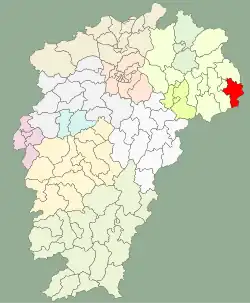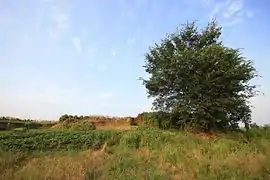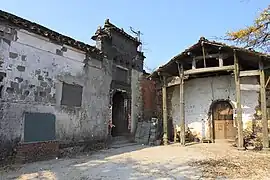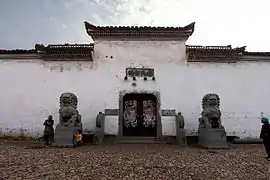Guangfeng
广丰区 Kwangfeng | |
|---|---|
 Juntan Reservoir | |
 Location in Jiangxi | |
| Coordinates: 28°26′18″N 118°10′46″E / 28.43833°N 118.17944°E | |
| Country | People's Republic of China |
| Province | Jiangxi |
| Prefecture-level city | Shangrao |
| Capital | Yongfeng |
| Area | |
| • Total | 1,377.79 km2 (531.97 sq mi) |
| Population (2017) | |
| • Total | 974,367 |
| • Density | 710/km2 (1,800/sq mi) |
| Time zone | UTC+8 (China Standard) |
| Postal code | 334600 |
| Area Code | 0793 |
| Vehicle registration | 赣E |
| Website | www |
Guangfeng District (simplified Chinese: 广丰区; traditional Chinese: 廣豐區; pinyin: Guǎngfēng Qū; lit. 'Wide and luxuriant') is a district of the city of Shangrao, located in Northeastern Jiangxi Province, Eastern China.
The easternmost county-level division of Jiangxi, Guangfeng borders Zhejiang and Fujian provinces. It covers 1,377.79 km2 (531.97 sq mi).
The population is 760,000 people.
History
The district was first established during the Tang dynasty in 758 as a county, then repealed in 812. In 1074, during the Song dynasty, the district was reestablished as a county.
Administration
Guangfeng has been a county for over 1,300 years. Administratively, the district is part of the prefecture-level city of Shangrao. The county administers 23 townships.
At present, Guangfeng District has 3 subdistricts, 16 towns and 4 townships.[1]
- 3 subdistricts
- Yongfeng (永丰街道)
- Lulin (芦林街道)
- Fengxi (丰溪街道)
- 16 towns
|
|
- 4 townships
|
|
Climate
The climate is temperate, with abundant rainfall during the monsoon season. It has clearly differentiated summers and winters.
| Climate data for Guangfeng (1991–2020 normals, extremes 1981–2010) | |||||||||||||
|---|---|---|---|---|---|---|---|---|---|---|---|---|---|
| Month | Jan | Feb | Mar | Apr | May | Jun | Jul | Aug | Sep | Oct | Nov | Dec | Year |
| Record high °C (°F) | 27.4 (81.3) |
29.6 (85.3) |
34.3 (93.7) |
35.4 (95.7) |
37.2 (99.0) |
38.0 (100.4) |
41.0 (105.8) |
41.4 (106.5) |
39.0 (102.2) |
37.2 (99.0) |
32.4 (90.3) |
25.9 (78.6) |
41.4 (106.5) |
| Mean daily maximum °C (°F) | 10.8 (51.4) |
13.5 (56.3) |
17.4 (63.3) |
23.6 (74.5) |
28.0 (82.4) |
30.1 (86.2) |
34.6 (94.3) |
34.2 (93.6) |
30.5 (86.9) |
25.5 (77.9) |
19.5 (67.1) |
13.4 (56.1) |
23.4 (74.2) |
| Daily mean °C (°F) | 6.4 (43.5) |
8.8 (47.8) |
12.5 (54.5) |
18.3 (64.9) |
23.0 (73.4) |
25.7 (78.3) |
29.4 (84.9) |
28.9 (84.0) |
25.3 (77.5) |
20.0 (68.0) |
14.2 (57.6) |
8.3 (46.9) |
18.4 (65.1) |
| Mean daily minimum °C (°F) | 3.4 (38.1) |
5.4 (41.7) |
8.9 (48.0) |
14.4 (57.9) |
19.2 (66.6) |
22.4 (72.3) |
25.3 (77.5) |
25.1 (77.2) |
21.5 (70.7) |
16.0 (60.8) |
10.3 (50.5) |
4.8 (40.6) |
14.7 (58.5) |
| Record low °C (°F) | −5.8 (21.6) |
−3.9 (25.0) |
−3.1 (26.4) |
1.9 (35.4) |
9.9 (49.8) |
13.3 (55.9) |
18.9 (66.0) |
19.0 (66.2) |
12.7 (54.9) |
4.0 (39.2) |
−1.8 (28.8) |
−9.6 (14.7) |
−9.6 (14.7) |
| Average precipitation mm (inches) | 87.5 (3.44) |
104.9 (4.13) |
207.4 (8.17) |
232.2 (9.14) |
219.5 (8.64) |
367.5 (14.47) |
149.8 (5.90) |
104.5 (4.11) |
73.0 (2.87) |
49.4 (1.94) |
92.8 (3.65) |
74.6 (2.94) |
1,763.1 (69.4) |
| Average precipitation days (≥ 0.1 mm) | 13.6 | 13.7 | 18.4 | 16.8 | 16.2 | 18.1 | 11.7 | 12.2 | 9.2 | 7.4 | 10.1 | 10.7 | 158.1 |
| Average snowy days | 2.8 | 1.8 | 0.2 | 0 | 0 | 0 | 0 | 0 | 0 | 0 | 0.1 | 0.9 | 5.8 |
| Average relative humidity (%) | 77 | 76 | 76 | 75 | 75 | 80 | 73 | 73 | 73 | 72 | 76 | 75 | 75 |
| Mean monthly sunshine hours | 89.8 | 90.9 | 100.7 | 126.6 | 148.1 | 133.9 | 230.8 | 220.1 | 182.5 | 169.2 | 131.5 | 120.1 | 1,744.2 |
| Percent possible sunshine | 27 | 29 | 27 | 33 | 35 | 32 | 54 | 55 | 50 | 48 | 41 | 38 | 39 |
| Source: China Meteorological Administration[2][3] | |||||||||||||
Economy
Guangfeng was once a poor district, but now it is one of the wealthiest counties of Jiangxi. The most famous industry of the district is the tobacco industry. The GDP of 2005 is 7.29 billion.
Features
Guangfeng's most famous feature is Boshan Temple, which lies in the west of the county. The Buddhist temple has a history over 1000 years. Xin Qiji, the famous poet of the South Song dynasty, visited it often.
Sheshantou Site, in Guangfeng District, is an important Neolithic archaeological site of Jiangxi Province.[4]
References
- ↑ "常州市-行政区划网 www.xzqh.org" (in Chinese). XZQH. Retrieved 2012-05-24.
- ↑ 中国气象数据网 – WeatherBk Data (in Simplified Chinese). China Meteorological Administration. Retrieved 28 June 2023.
- ↑ 中国气象数据网 (in Simplified Chinese). China Meteorological Administration. Retrieved 28 June 2023.
- ↑ Wan Z, Yang X, Quansheng G E, et al. Plant Resource Utilization at Sheshantou Site in Jiangxi Province Based on Starch Grain Analysis[J]. Progress in Geography, 2012.
Gallery
 Sheshantou Site
Sheshantou Site Liushiyan Hill
Liushiyan Hill Jiuxianshan Castle
Jiuxianshan Castle Baihuayan Hill
Baihuayan Hill Yushi Hill
Yushi Hill Songfeng Temple
Songfeng Temple Zhu's ancestral hall in Longxi
Zhu's ancestral hall in Longxi